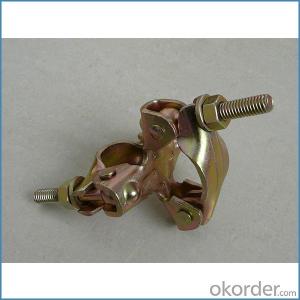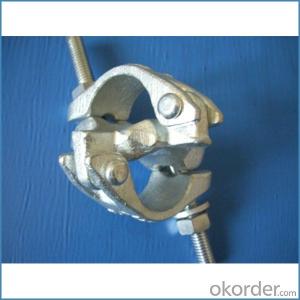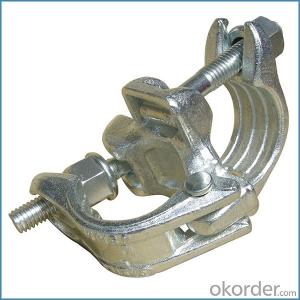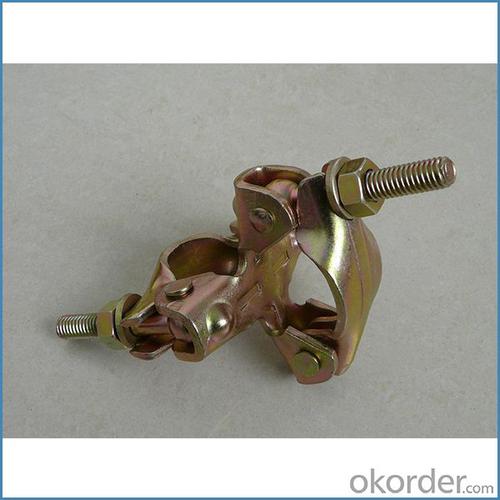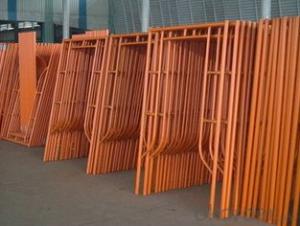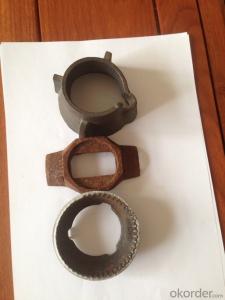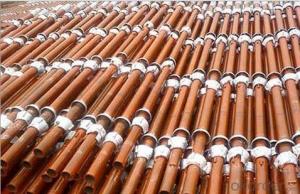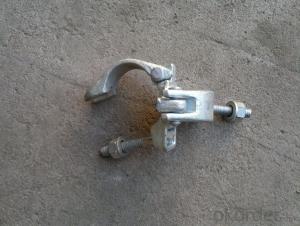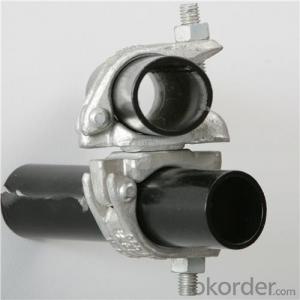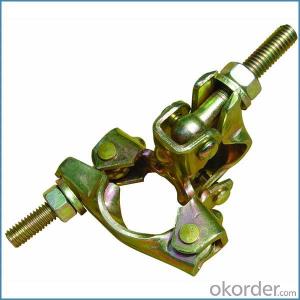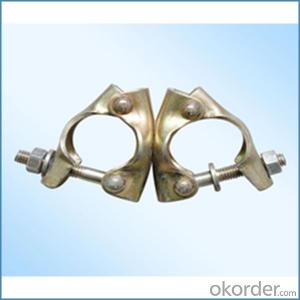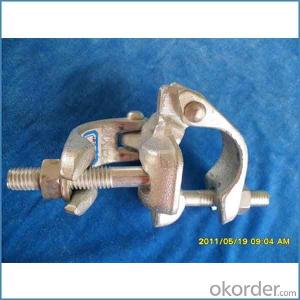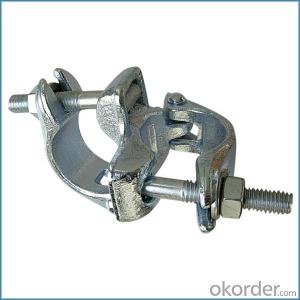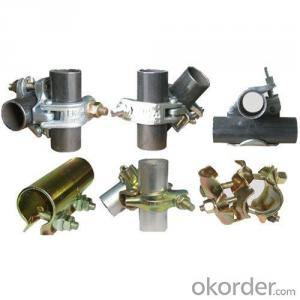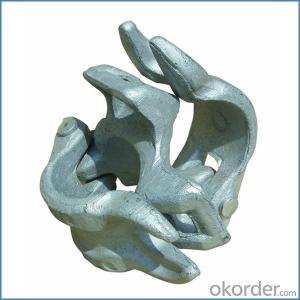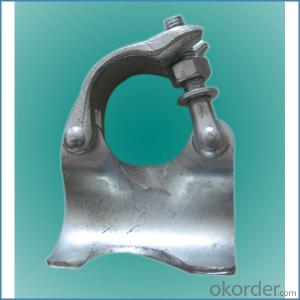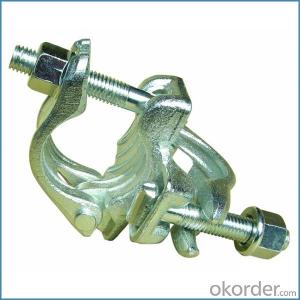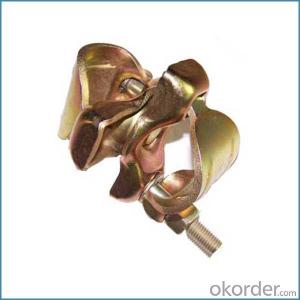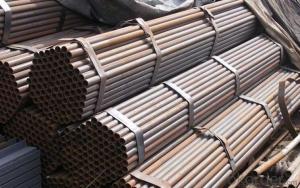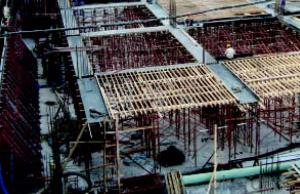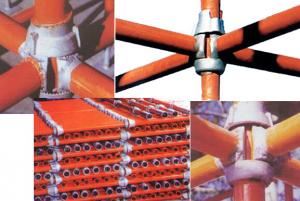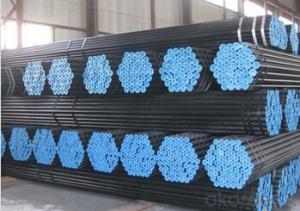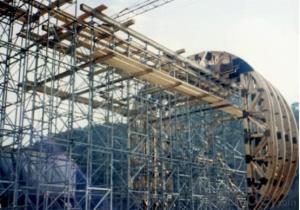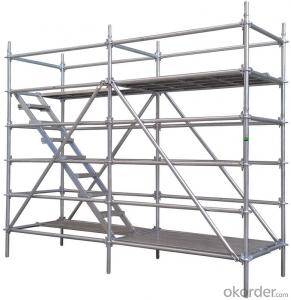Scaffolding Spring Clamp british German Forged Type
- Loading Port:
- Tianjin
- Payment Terms:
- TT OR LC
- Min Order Qty:
- 1000 kg
- Supply Capability:
- 100000 kg/month
OKorder Service Pledge
OKorder Financial Service
You Might Also Like
Scaffolding Spring Clamp british German Forged Type
Description
1.The scaffolding coupler is always used to connect the steel pipe as scaffolding system.
2.The often used coupler is swivel coupler and righ angle coupler .
3.We can provide types of scaffolding coupler according to your requirement.
4.Couoler can fix the 48.3mm scaffolding steel pipe tightly and make the whole scaffolding system more steadily.
Feature
(1)Excellent Anti-Breaking—Cold Pressed Steel
(2)Outstanding Resistance Deformation
(3)Strong Anti-Dropping Ability
Photo
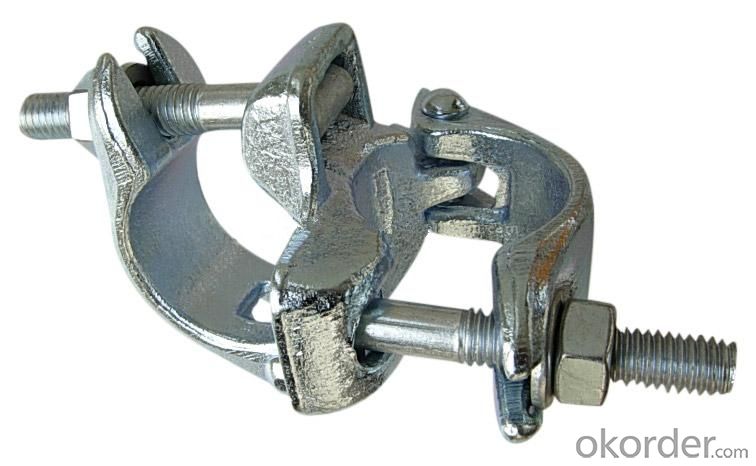
Parameter
| Material | Q235,345steel |
| Size | 48.3mm*48.3mm |
| Surface finish | Galvanized |
| Weight | 1.1kg around |
| Standard | BS1139,EN74 |
| Package | 25pcs/bag,steel pallet |
| Manufacture | As per customer requirement |
| Market | Africa, South America, the Middle East and Asia |
FAQ
Q: Are you a factory or trading company?
We are a state-owned corporation in China,dealing with various kinds of building materials.We have our holding subsidiaries.
Q: Where is your factory located? How can I visit there?
Our factory is located all around China.
Q: Can I get some samples?
Sample is free, customer only pay freight for the first time.
Q: Delivery?
10-30days. (5-15 containers)
Any question,feel free to contact us.
- Q: Are there any specific guidelines for the safe use of steel tube couplers in scaffolding near areas with high levels of airborne contaminants or pollutants?
- Steel tube couplers used in scaffolding near areas with high levels of airborne contaminants or pollutants require specific guidelines to ensure safe use. It is crucial to prioritize the health and safety of workers in such environments. To achieve this, the following measures should be taken: 1. Conduct a thorough risk assessment to identify potential hazards associated with airborne contaminants or pollutants present in the area. This assessment should consider the type, concentration, and toxicity of the contaminants. 2. Select steel tube couplers that resist corrosion and deterioration caused by the specific contaminants in the environment. Use high-quality materials that can withstand exposure to airborne pollutants. 3. Regularly inspect the steel tube couplers to detect any signs of corrosion, deterioration, or damage that could compromise their integrity. Replace any couplers showing wear and tear or unsuitable for use. 4. Implement appropriate protective measures to minimize workers' exposure to airborne contaminants. This includes providing suitable personal protective equipment (PPE) like respirators, gloves, and protective clothing. Promote proper hygiene practices such as hand and face washing after work. 5. Provide comprehensive training to workers regarding the potential hazards associated with working in areas with high levels of airborne contaminants or pollutants. Train them on the correct use of PPE and safe work practices to reduce exposure risks. 6. Ensure the scaffolding area has adequate ventilation to decrease the concentration of airborne contaminants. This can be achieved through the use of fans, air purifiers, or positioning the scaffolding in areas with better air quality. 7. Regularly clean and maintain the scaffolding equipment, including the steel tube couplers, to prevent the accumulation of contaminants that could compromise their structural integrity. 8. Comply with all relevant safety regulations, standards, and guidelines set by local authorities and regulatory bodies. Adhere to any additional specific guidelines provided for working with scaffolding in areas with high levels of airborne contaminants. By adhering to these guidelines, employers can minimize the risks associated with using steel tube couplers in scaffolding near areas with high levels of airborne contaminants or pollutants, ensuring the safety and well-being of workers.
- Q: Can steel tube couplers be used in scaffolding projects with uneven or sloped surfaces?
- Steel tube couplers, which can be utilized in scaffolding ventures involving uneven or sloped surfaces, are engineered to establish reliable and robust connections between steel tubes. These couplers possess exceptional adaptability, enabling them to conform to diverse angles and surfaces, even those that are uneven or sloped. With the incorporation of adjustable couplers, the scaffolding can effortlessly be modified to suit the precise demands of the undertaking, guaranteeing both stability and safety. Ensuring the proper construction of the scaffolding and securely tightening the couplers are vital in maintaining the structural integrity of the scaffolding.
- Q: Are steel tube couplers resistant to extreme temperatures?
- Yes, steel tube couplers are generally resistant to extreme temperatures. Steel is known for its high temperature resistance, making it suitable for various applications in extreme environments. Steel tube couplers are designed to withstand high temperatures without losing their strength or structural integrity. This makes them suitable for use in industries such as oil and gas, chemical processing, and power generation, where extreme temperatures are common. However, it is important to note that the specific temperature range within which a steel tube coupler can operate effectively may vary depending on its grade and composition. Therefore, it is advisable to consult the manufacturer or supplier for detailed information on the temperature resistance of a specific steel tube coupler.
- Q: What are the common quality control measures for steel tube couplers in scaffolding?
- There are several common quality control measures for steel tube couplers used in scaffolding. These measures aim to ensure that the couplers meet the necessary standards and are safe to use. Some of the common quality control measures include: 1. Visual Inspection: A visual inspection is conducted to check for any visible defects, such as cracks, burrs, or deformities in the couplers. This inspection helps identify any issues that may affect the performance or structural integrity of the coupler. 2. Dimensional Inspection: Dimensional inspection involves measuring the critical dimensions of the coupler, such as diameter, height, and width. This ensures that the couplers are manufactured within the required tolerances and will fit properly with the scaffolding tubes. 3. Load Testing: Load testing is performed to assess the load-bearing capacity of the coupler. This involves subjecting the coupler to a specified load and monitoring its performance. Load testing helps determine if the coupler can withstand the expected loads without failure. 4. Material Testing: Material testing is carried out to verify the composition and quality of the steel used in manufacturing the couplers. This includes testing for tensile strength, yield strength, hardness, and chemical composition. These tests ensure that the couplers are made from high-quality steel and will provide the necessary strength and durability. 5. Corrosion Resistance Testing: Couplers used in scaffolding are often exposed to harsh environmental conditions, including moisture and corrosive substances. Therefore, corrosion resistance testing is crucial to assess the coupler's ability to withstand corrosion over time. This testing is typically done by subjecting the couplers to a salt spray or immersion test to simulate corrosive conditions. 6. Certification and Compliance: Couplers used in scaffolding should meet specific industry standards and regulations. Therefore, obtaining relevant certifications, such as ISO 9001 or EN 74, is an important quality control measure. Compliance with these standards ensures that the couplers have undergone rigorous testing and meet the necessary safety requirements. In conclusion, common quality control measures for steel tube couplers in scaffolding include visual inspection, dimensional inspection, load testing, material testing, corrosion resistance testing, and certification and compliance. These measures help ensure that the couplers are of high quality, safe to use, and capable of withstanding the demanding conditions of scaffolding applications.
- Q: Can steel tube couplers be used in scaffolding projects with delicate surfaces?
- When working on scaffolding projects with delicate surfaces, it is crucial to safeguard the surface from potential harm when using steel tube couplers. One effective method is to employ protective materials like rubber or foam padding on the couplers or any points of contact between the scaffolding and the delicate surface. Moreover, it is imperative to ensure the proper erection and stabilization of the scaffolding in order to minimize any movement or vibration that may result in damage. Additionally, regular inspections should be carried out to identify and address any potential issues or damage to the delicate surface. In conclusion, while steel tube couplers can be utilized in such projects, it is of utmost importance to exercise extra caution to shield the delicate surfaces and avert any damage.
- Q: How do you calculate the required number of steel tube couplers for a specific scaffolding project?
- To determine the necessary quantity of steel tube couplers for a particular scaffolding undertaking, several crucial factors must be taken into account. Initially, you must ascertain the total length of tubes to be utilized in the project. This can be achieved by measuring the gaps between each platform or level of the scaffold, as well as the vertical height required. Subsequently, you need to identify the types of connections that will be established using the steel tube couplers. For instance, if you plan to connect two tubes in a straight line, one coupler will suffice. However, if you intend to create a corner or an intersection, multiple couplers may be necessary to ensure stability and safety. In addition, the load-bearing capacity of the scaffolding must be considered as this will dictate the spacing and quantity of couplers required. Referring to the manufacturer's guidelines or industry standards for the specific load ratings of the couplers and calculating the maximum load capacity of each connection point will aid in determining the number of couplers needed to evenly distribute the load throughout the structure. Finally, any additional factors such as safety regulations or local building codes that specify specific requirements for the number of couplers needed should be taken into account. By thoroughly considering these factors, you will be able to accurately calculate the requisite number of steel tube couplers for your particular scaffolding project. It is always advisable to consult a professional engineer or scaffolding specialist to ensure compliance with safety standards and regulations.
- Q: A 67.0kg- painter is on a uniform 23kg- scaffold supported from above by ropes. There is a 3.6kg- pail of paint to one side, as shown .
- Painter Scaffold
- Q: What are the common quality control measures for steel tube couplers?
- The common quality control measures for steel tube couplers include dimensional checks, visual inspections, mechanical tests such as tensile and compression strength, corrosion resistance testing, and non-destructive testing methods such as ultrasonic or magnetic particle inspection. These measures ensure that the couplers meet the required specifications, standards, and safety regulations before being used in various applications.
- Q: What are the common maintenance procedures for steel tube couplers in scaffolding?
- Common maintenance procedures for steel tube couplers in scaffolding include regular inspection for any signs of damage or wear, such as cracks or deformation. Couplers should be cleaned and lubricated regularly to prevent rust and ensure smooth operation. Worn or damaged couplers should be replaced immediately to maintain the structural integrity and safety of the scaffolding system.
- Q: How do steel tube couplers prevent accidental dislodging or separation of scaffolding components?
- Steel tube couplers prevent accidental dislodging or separation of scaffolding components by securely connecting and interlocking the tubes together, providing a strong and stable structure. These couplers are designed to withstand heavy loads and external forces, ensuring that the scaffolding remains intact and safe during use.
Send your message to us
Scaffolding Spring Clamp british German Forged Type
- Loading Port:
- Tianjin
- Payment Terms:
- TT OR LC
- Min Order Qty:
- 1000 kg
- Supply Capability:
- 100000 kg/month
OKorder Service Pledge
OKorder Financial Service
Similar products
Hot products
Hot Searches
Related keywords
